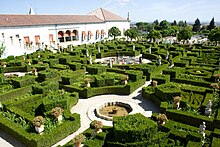Castelo Branco is a city of 56,000 people (2011) in central Portugal. All its points of interest can be visited in one day. It is also a good base for visiting the International Tagus Natural Park, the Serra da Estrela Natural Park, and Idanha-a-Nova.
Understand
edit
Castelo Branco (kuhsh-TEH-loo BRUHN-koo, /kɐʃ.ˈtɛ.ɫu ˈbɾɐ̃.ku kɐʃ/) is the capital of the Castelo Branco District, which approximately corresponds to the former Beira Baixa province.
Climate
edit
Castelo Branco has a hot-summer Mediterranean climate. Its summers are among the hottest of Portugal, influenced by its inland position. Winters are mild with cool nights, but frosts are rare and never severe. Inland areas further south in the country have hotter temperature extremes, although averages are very similar. There is somewhat of a seasonal lag in summer since September is significantly warmer than May in spite of less daylight. Winter temperatures are more consistent with the daylight cycle, since temperatures drop sharply in autumn months.
Visitor information
edit- 1 Posto de Turismo, Avenida Nuno Álvares 30 (Praça do Município), ☏ +351 272 330 339, turismo@cm-castelobranco.pt. M–F 09:30–19:30, Sa Su 09:30–13:00 & 14:30–18:00.
Get in
editBy train
editCP (Portuguese National Railways) offers various daily rail links between Lisbon and Beira Baixa. The Lisbon-Castelo Branco trip time is between 2:40 and 3:15 hours (depending upon class of train). In the Lisbon-Oriente train station there is also a rail link to the south of the country and in the Entroncamento station there is a rail link to the northern reaches, as well as international service to France and Spain. The train is safe, comfortable, and offers the best views of the Tagus River, including the Castle of Almourol and the Portas de Ródão.
By bus
editThe cheapest way to travel. Bus lines cover all of Portugal. See Rede Expressos[dead link].
Get around
editSee
editMonuments
edit
- 1 Templar Castle (Castelo de Castelo Branco). It was built by the Knight Templars between 1214-1230, with alterations in the reign of King Dinis. Parts of the perimeter wall and the keep of the former commanders' palace remain. Inside the perimeter of the walls is the Church of Saint Maria of the Castle. The view from the top is impressive - including the city, the surrounding countryside, and (in the distant north) the Estrela and Gardunha mountain ranges.
- 2 Church of Saint Maria of the Castle (Igreja de Santa Maria do Castelo). Much changed by renovations over the years. Located in the highest part of the city, near the remains of the castle. Established by the Templars.

- 3 Garden of the Episcopal Palace (Jardim do Paço Episcopal). One of the most extraordinary baroque Portuguese gardens and, for you alone, it would justify the visit to the city. Built in the 18th century on the initiative of the first Bishop of Castelo Branco, next to the winter palace which today houses the Museum Junior Tavares Proença. The garden is unique in its originality and elegance. Of baroque inspiration, between his avenues of box trees are numerous granite statues which represent (among other things) the four parts of the world then known (Europe, Asia, Africa and India), the signs of the Zodiac, the stations of the year and his months. From the great lake, where it comes to Moses's waterfall, they break two monumental staircases, that of the Kings and of the Apostles. Notably, among the images of the Kings of Portugal, the representations of the Filipes of the Third Dynasty, as well as that of the Cardinal-King Henry (due to his Castilian sympathies), were sculpted smaller than the rest.
- 4 Church of Saint Miguel (Cathedral Concatedral). Rebuilt Renaissance style in the 18th century (previously there was another church here, probably built in the 14th or 17th century). It has only one nave, which is separated from the main chapel by a beautiful Renaissance arch, in whose fastening is the coat of arms of arms of D. Martim Afonso de Melo, bishop of Guarda.
- 5 Chapel of the Lady of Mercy (Capela De Nossa Senhora da Piedade). The inner walls of this church, about which the date of the foundation is not known, are covered of beautiful ceramic tiles of the 18th century, which represent religious subjects: scenes of the life of the Virgin Maria, the Apostles, the Last supper of Jesus, etc.
- 6 Chapel of Our Lady of Mércoles (Ermida de Nossa Senhora de Mércoles). A church of late Gothic characteristics, connected with one of the most popular worships of the city, of Our Lady of Mércoles. Two square turrets that flank the front, advanced regarding the facade and finish with pyramidal covering, give it a curious aspect. The interior, of a nave, has walls covered in 16th century ceramic tiles.
Museums
edit- 7 Francisco Tavares Proença Júnior Museum.
- 8 Museum Cargaleiro, Rua dos Cavaleiros 23, ☏ +351 272 337 394, museu.cargaleiro@cm-castelobranco.pt.
- 9 Museu de Arte Sacra "Domingos Santos Pio" ("Domingos dos Santos Pio" Museum of Religious Art), Rua Bartolomeu da Costa 42. Located in the Graça Convent. Among the museum's collection we find two Crists crucified in ivory from the 16th and 17th centuries, and a Christ in wood painted with oriental forms.
Do
editBuy
editEat
edit- 1 Cabra Preta, Rua de Santa Maria 13, ☏ +351 272 030 303, geral@cabrapreta.pt. M–Sa 12:00–15:00 & 10:00–22:00, Su 12:00–15:00. Seafood, meats, and vegetarian options. €10-30.
- 2 Casa das Bifanas, Rua Poeta João Roiz 6D. Su–Th 08:00–01:00F 08:00–15:00, closed Sa. Specializing in thinly-sliced pork cutlet sandwiches. Budget.
- 3 Palitão, ☏ +351 272 035 186, restaurantepalitao@hotmail.com. M 19:00–22:30, Tu–Sa 12:00–22:30, closed Su. Steakhouse. Mid-range.
Drink
editSleep
edit
- 1 Casa de Belgais, Monte Dragão, S/N, Sítio da Lameira Brava, Escalos de Baixo, ☏ +351 272 107 664.

